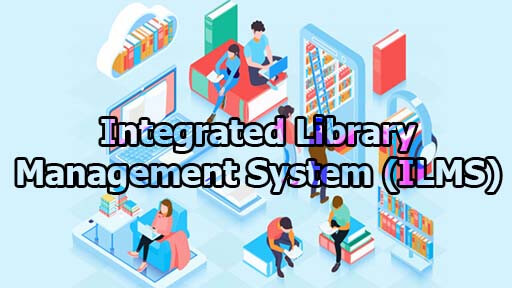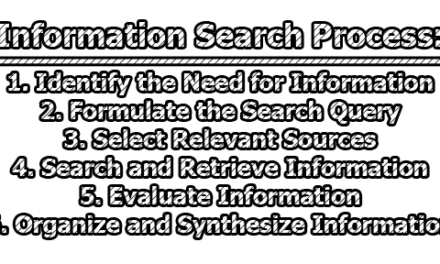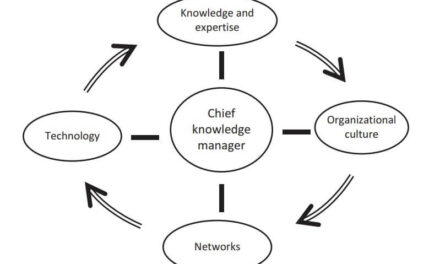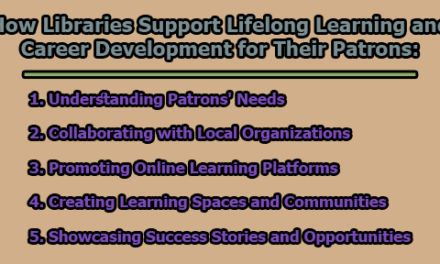Integrated Library Management System (ILMS):
An Integrated Library Management System (ILMS) is a software platform designed to manage and automate library operations. ILMS software can manage several aspects of library services such as collection management, cataloging, circulation, acquisitions, serials management, and reporting. ILMS is considered an essential tool for academic and research libraries, which enables them to provide efficient and effective services to their users.
ILMS software typically includes a central database that stores all library-related data and an intuitive user interface that facilitates the management of library operations. The system allows librarians to perform a range of functions such as cataloging, circulation, and inventory management in a streamlined manner.
The benefits of an ILMS include enhanced efficiency, improved user experience, and increased productivity of library staff. With the help of ILMS, librarians can easily manage library operations and offer enhanced services to users. Moreover, it allows librarians to track and manage library resources in real time, providing insights into the usage and demand of library resources.
So, an ILMS is a software system designed to automate and manage library operations, providing librarians with the tools they need to manage their collections and services efficiently and effectively.
Features of Integrated Library Management System (ILMS):
An Integrated Library Management System (ILMS) is a software platform designed to manage and automate library operations, allowing librarians to efficiently and effectively manage their collections and services. ILMS software typically includes a central database that stores all library-related data and an intuitive user interface that facilitates the management of library operations. Here, we will explore the various features of an ILMS, including cataloging, circulation, acquisitions, serials management, reporting and analysis, interlibrary loan, and patron management.
- Cataloging: Cataloging is the process of creating a catalog of library materials, including books, journals, audiovisual materials, and other resources. The ILMS software provides tools for cataloging and managing the bibliographic data associated with library resources. Cataloging features may include the ability to search, retrieve, and modify bibliographic data, as well as the ability to create and print catalog cards and labels.
ILMS software typically supports industry-standard cataloging formats, such as MARC (Machine-Readable Cataloging) and Dublin Core. MARC is a widely used format for bibliographic data that includes fields for title, author, subject headings, and other descriptive data. Dublin Core is a simpler, more flexible format that allows for the creation of metadata that can be used to describe a wide variety of digital resources.
- Circulation: Circulation refers to the process of lending library materials to patrons and tracking their use. ILMS software provides tools for managing circulation activities, including checking materials in and out, placing holds, renewing loans, and managing fines and fees. Circulation features may also include the ability to generate reports on circulation statistics and usage patterns.
ILMS software typically includes a user-friendly interface for managing circulation activities. This interface may be integrated with the library’s online catalog, allowing patrons to search for and request materials from the comfort of their own homes.
- Acquisitions: Acquisitions refer to the process of selecting and purchasing library materials, including books, journals, and other resources. ILMS software provides tools for managing the acquisitions process, including the ability to search for and order materials from vendors, track the status of orders, and manage invoices and payments.
Acquisitions features may also include the ability to create and manage purchase orders, generate reports on acquisition activities, and track the budget allocated for library materials.
- Serials Management: Serials management refers to the process of managing library subscriptions to journals, magazines, and other periodicals. ILMS software provides tools for managing the serials management process, including the ability to track subscription information, manage renewals and cancellations, and maintain accurate records of serials holdings.
Serials management features may also include the ability to generate reports on usage patterns and subscription costs, as well as the ability to manage electronic journals and other digital resources.
- Reporting and Analysis: Reporting and analysis refer to the process of generating reports on library activities and analyzing data to identify usage patterns and trends. ILMS software provides tools for generating reports on circulation statistics, acquisitions activities, serials management, and other library operations.
Reporting and analysis features may include the ability to customize reports based on user-defined criteria, export reports to other formats, and generate graphical representations of data.
- Interlibrary Loan: Interlibrary loan refers to the process of borrowing materials from other libraries on behalf of patrons. ILMS software provides tools for managing interlibrary loan requests, including the ability to search for and request materials from other libraries, track the status of requests, and manage incoming and outgoing loan transactions.
Interlibrary loan features may also include the ability to generate reports on interlibrary loan activities and track the cost of borrowing materials from other libraries.
- Patron Management: Patron management refers to the process of managing patron accounts, including the ability to track patron activity, manage holds and renewals, and provide support for reference and research needs. ILMS software provides tools for managing patron accounts, including the ability to create and edit patron records, track borrowing history, and manage fine and fee payments.
Patron management features may also include the ability to communicate with patrons via email or SMS, provide customized recommendations based on patron preferences and borrowing history, and manage patron requests and feedback.
- Electronic Resource Management: Electronic Resource Management (ERM) refers to the process of managing electronic resources such as e-books, databases, and other digital content. ILMS software provides tools for managing ERM activities, including the ability to track licensing and usage agreements, manage access and authentication, and track usage statistics.
ERM features may also include the ability to integrate with discovery systems to make electronic resources easily discoverable, as well as the ability to provide alerts and notifications to users when new electronic resources become available.
- Mobile Access: Mobile access refers to the ability to access library services and resources using mobile devices such as smartphones and tablets. ILMS software provides tools for managing mobile access, including the ability to create mobile-optimized interfaces for the library’s online catalog, circulation system, and other library services.
Mobile access features may also include the ability to provide real-time notifications to users, such as reminders to return materials, and the ability to allow users to renew materials, place holds, and perform other library functions using their mobile devices.
- Integration with External Systems: Integration with external systems refers to the ability to integrate ILMS software with other software systems used by the library or other external systems such as learning management systems or digital repositories. ILMS software provides tools for managing these integrations, including the ability to import and export data, synchronize data between systems, and provide APIs (Application Programming Interfaces) for other systems to access library data.
Integration features may also include the ability to provide single sign-on (SSO) functionality, allowing users to access multiple library systems using a single set of credentials. This can help to simplify the user experience and make it easier for patrons to access the library’s services and resources.
Why do Modern Libraries Heavily Rely on ILMS?
Modern libraries heavily rely on Integrated Library Management Systems (ILMS) because they provide a centralized system for managing library operations and services. Here are some of the key reasons why libraries use ILMS:
- Efficient Management of Library Operations: An ILMS can automate and streamline library operations, such as cataloging, acquisitions, circulation, and interlibrary loan. This can help libraries to manage their collections more efficiently and effectively, freeing up staff time for other tasks.
- Improved Access to Library Resources: ILMS software provides tools for managing online catalogs, providing patrons with access to the library’s collections and resources from anywhere, anytime. This can help libraries to provide better service to patrons and improve the user experience.
- Data Analysis and Reporting: ILMS software provides tools for generating reports and analyzing library data, such as circulation statistics, resource usage, and patron demographics. This can help libraries to make data-driven decisions about their collections and services and improve the quality of their services.
- Integration with External Systems: ILMS software can be integrated with other library systems, such as discovery systems, learning management systems, and digital repositories. This can help libraries to provide seamless access to their resources and services, making it easier for patrons to find and use library materials.
- Cost Savings: An ILMS can help libraries to save money by automating routine tasks, reducing staff time spent on manual processes, and improving the accuracy of data. This can help libraries to allocate resources more efficiently and reduce costs associated with manual processes.
- Customization and Flexibility: Many ILMS software provides customization and flexibility features that allow libraries to tailor the system to their specific needs. This can include customization of the online catalog, circulation rules, reporting templates, and more. Libraries can choose the features and modules they need, enabling them to create a system that fits their unique requirements.
- Security and Privacy: With the increasing amount of personal data that libraries handle, security and privacy are of utmost importance. ILMS software provides features that ensure data security and privacy, including user authentication, access controls, data encryption, and audit trails. These features protect sensitive patron and library data from unauthorized access, ensuring that patrons can use library resources with confidence.
- Collaboration and Resource Sharing: ILMS software can help libraries to collaborate and share resources with other libraries. Many ILMS software provides interlibrary loan features that allow libraries to borrow and lend materials to each other. Additionally, some systems provide collaborative cataloging features that enable libraries to share bibliographic records, reducing the need for duplication of effort.
- User Engagement: ILMS software can help libraries to engage with their patrons and promote library services. Many systems provide features that allow libraries to create and manage online events, such as book clubs, author talks, and workshops. These features can help libraries to build community and promote their services to a wider audience.
- Accessibility: Finally, ILMS software can help libraries to ensure that their resources and services are accessible to all patrons, regardless of ability. Many systems provide accessibility features, such as text-to-speech functionality, screen readers, and keyboard shortcuts, to enable patrons with disabilities to use library resources with ease.
It is apparent that the Integrated Library Management System (ILMS) has become an indispensable tool for libraries of all types and sizes. ILMS provides a centralized system for managing library operations, including cataloging, circulation, acquisitions, serials management, reporting and analysis, interlibrary loan, and patron management. The software streamlines library workflows, saves staff time, and improves the user experience. Moreover, ILMS software provides features that ensure data security and privacy, protecting sensitive patron and library data from unauthorized access. This has become increasingly important as libraries handle more personal data.
References:
- Adesanya, T., & Alabi, S. (2020). Integrated Library Management System (ILMS) and Its Implications for Library Services in the 21st Century. Journal of Educational Media and Library Sciences, 57(1), 1-13.
- Bhatt, P., & Patel, K. (2016). Implementation of an integrated library management system in the library of Navrachana University, Vadodara. International Journal of Information Dissemination and Technology, 6(4), 262-268.
- Chowdhury, G. G. (2010). Introduction to digital libraries. Facet publishing.
- Farkas-Conn, I. (2018). Serving Online Patrons: A Practical Guide for Librarians. Rowman & Littlefield.
- Kargbo, J. A., & Mathews, C. C. (2018). Integrated library management system: An indispensable tool for libraries. The Electronic Library, 36(4), 655-669.
- Kelly, B., & Mustaine, K. (2015). Mobile library services: Best practices and technology applications. Library Technology Reports, 51(2), 5-44.
- King, D. L., & Willett, R. P. (2018). The Online Catalog Book: Essays and Examples. McFarland.
- Li, Y., Li, X., & Li, B. (2017). Research on the integrated library management system. Journal of Information Science Theory and Practice, 5(3), 7-16.
- Matarazzo, J. M., & Pearlstein, T. A. (2014). The ALA Guide to information access: A complete research handbook and Directory. American Library Association.
- Pal, S. (2014). Library management software and its application in libraries: A review. International Journal of Library Science and Research, 4(2), 21-34.
- Pearce-Moses, R. (2018). A Glossary of Archival and Records Terminology. Society of American Archivists.
- Singh, G., & Gupta, R. (2017). Library automation and networking. In Library Automation and Networking (pp. 25-42). Springer.
- Wang, J., & Wei, H. (2015). Design and implementation of a web-based integrated library management system. Journal of Computer Applications, 35(4), 985-987.
- Xia, L. (2018). Electronic resource management in academic libraries. In Handbook of Research on Emerging Trends and Technologies in Library and Information Science (pp. 393-413). IGI Global.

Library Lecturer at Nurul Amin Degree College










